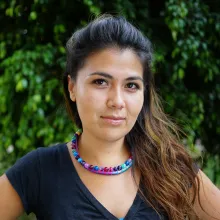
The Kawésqar people and the defense of their "maritorio" in Chile
Photo: Greenpeace ChileBy Liliana Ávila and Cristina Lux*
A little over a month ago, the community Kawésqar Grupos Familiares Nómades del Mar sent us a very special invitation. The appointment was near the sea, near their territory, or more precisely, near their "maritorio", a place of islands, islets and archipelagos. There, the borders between sea and land are blurred and the trees grow sideways, adapted to the strong winds.
The maritorio is a concept and also a way of inhabiting and understanding the world. It evokes the image of "territory", but seen from and in the sea. As a concept, it emerged in the context of what is known as nisology, or the study of islands.
The place we visited is located in the fjords of Magallanes, the southernmost region of Chile, about two hours from Punta Arenas, the regional capital.
The Kawésqar people tell us that less than a century ago, this maritorio was their home. There, their grandfathers and grandmothers sailed among the fjords, built their canoes, fished and dived. They went into the icy sea without special neoprene suits, protected with sea lion oil, and there they learned the secrets that its depths held.
In the midst of fjords, winds and intense climates, these people developed their own systems of thought and life.
But the lives of the Kawésqar have changed radically in recent decades. They tell us so. The vast territory that previous generations inhabited for centuries is now enclosed. The process of eradication has been accompanied by the commercialization of the land, the creation of extensive pastures and, more recently, the development and expansion of the salmon farming industry.
Industrial salmon production has serious and lasting impacts on marine ecosystems. The communities of Kawésqar are well aware of this. Salmon is an exotic and carnivorous species for Chile, raised in huge farms: hectares of cages in the sea.
The introduction of exotic species (which threaten native species), the excessive use of antibiotics, salmon escapes, the generation of waste, the treatment of large quantities of dead salmon, the excessive discharge of organic matter into the sea, and the generation of anaerobic environments (total or partial loss of oxygen necessary for life to thrive) are just some of the impacts of salmon farming in Chile.
These impacts not only accumulate in the waters and on the seabed, but also penetrate the lives of the Kawésqar communities. The maritorio that their grandfathers and grandmothers sailed is now a desecrated space.
The processes of reconstructing their identity, the appropriation of sacred places and the rites that are part of their collective memory have been affected by the development of an industry that sees the sea only as a space of economic exploitation and not as the sacred place where, in the not so distant past, men and women developed their worldviews and ways of life.
Despite everything, the Kawésqar are a living people who meet, who gather around the sea and discuss strategies to rebuild their cultural fabric. They also come together to honor their grandfathers and grandmothers, to activate the genetic memory that connects them to the sea, to dive into its waters and fight for a salmon-free sea and for a country that recognizes the cultural diversity that runs through its history.
We also connect with the legacy of the Kawésqar. Swimming with people from the community in these seas that have been navigated for thousands of years allowed us to look out a window that blurs the present and shows us alternatives. A present that allows life and coexistence with the sea, its ecosystems and its balance.
Their struggle— supported by AIDA, the NGO FIMA, Greenpeace and many other organizations— has borne fruit. It has highlighted the impact of salmon farming in Chile and the need to end our dependence on it.
But the challenges are still enormous. Salmon farming continues to ravage the seas inside and outside protected areas, in the most remote areas of Patagonia, occupying spaces that were once shared by all the peoples and creatures that inhabited the territory.
Meanwhile, the people of Kawésqar continue to travel through their territory —rewarded and lived in and from the sea— identifying and recomposing their history, swimming in the waters that surround them.
They do not lose hope of returning to their sea; they to continue to exist in it.
*Liliana Avila is coordinator of AIDA's Human Rights and Environment Program; Cristina Lux is an attorney with the Climate Program.
Liliana Ávila

Liliana A. Ávila is the Director of AIDA's Human Rights and Environment Program. A Colombian, she works from the Bogotá office. Liliana is an attorney from the Universidad Externado de Colombia, a specialist in constitutional law, and holds a Masters in Legal Argumentation from the University of Alicante in Spain. She has experience in international human rights law and international systems for the protection of human rights. She's a professor of international law at the Universidad Externado and has worked as a legal advisor on human rights, international humanitarian law, and public health.
